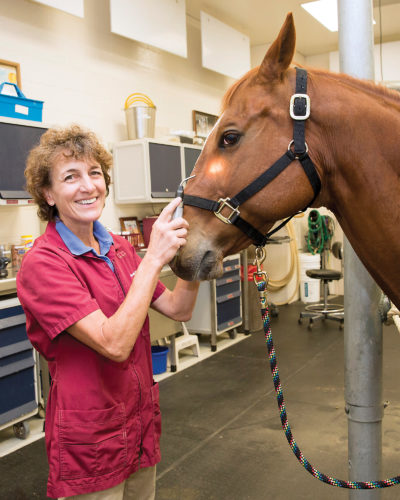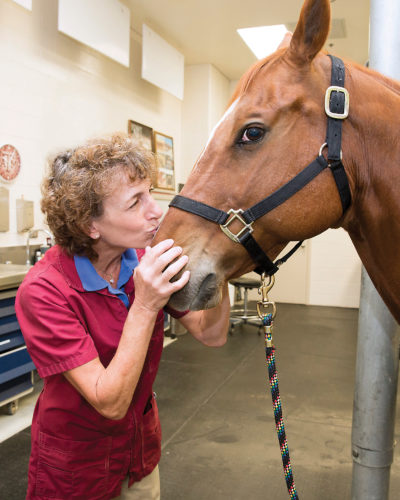A Hardy Dose of Care
Story by Dr. Megan Palsa
Dr. Joanne Hardy, a clinical associate professor of veterinary surgery at the Texas A&M Large Animal Hospital (LAH), hails from Quebec, Canada. She received her Doctor of Veterinary Medicine (DVM) degree from the University of Montreal —the only French veterinary school in North America. After veterinary school, she completed a residency at The Ohio State University.

Hardy joined the faculty at Ohio State and obtained board certifications in veterinary surgery and in veterinary emergency and critical care. During this time, she was invited to Texas A&M University to speak at a conference and she really liked the environment—and the College Station area in general—and when a job opened up at Texas A&M’s College of Veterinary Medicine & Biomedical Sciences (CVM), she immediately applied for it and got the job.
As a clinician, Hardy is responsible for the emergency and critical care service in the LAH, which consists of medical, surgical, and food animal faculty who deal with the daytime cases and share the after-hours emergency duty.
“What we see is anything from a horse with a fever to major surgical candidates, such as abdominal surgery and colic, to neonatal emergency cases,” Hardy said. “We receive many food animal emergencies, which can include llamas, pigs, cattle, goats, and sheep. In fact, I’m bringing my own sheep today to be looked at by the food animal faculty, so it’s a heavy after-hours schedule, for sure.
“The problem is people come home from work at 5 o’clock and then they find their animals sick, so that becomes an after-hour problem. We see everything; if it’s a concern for the owner, it’s a concern for us,” she said.
Students participate in all of the work at the LAH, which is a great opportunity for them to see more emergent or urgent disease and illnesses, as well as to participate in the triaging of those cases. Whether the animal needs to have immediate surgery, or just monitored, it’s a good opportunity for the students to learn in the hospital environment.
The LAH also has a great intensive care service. The service is top-of-the-line and the technicians are some of the best in the country.
There are at least two technicians, oftentimes three or four, in the hospital after hours at all times; they participate in receiving the emergencies and getting started with the diagnostics. The hospital staff can perform pretty much any diagnostics that need to be done, according to Hardy.
“I’ve seen times when we’ve had horses with head injuries that needed to get an MRI imaging, or a CT, done—or whatever needs to be done, really—on a Sunday and we got it done,” she said. “So, at any time, I think our faculty and our technicians are absolutely fantastic to jump in and help out. It takes a village and we’ve got a great village, that’s for sure.”
Hardy also fulfills the college mission of teaching. With the college’s recent implementation of a new curriculum, clinicians teach with a more hands-on approach.
“The students, from day one, learn a lot of hands-on skills,” she said. “There are a lot more hands-on laboratories and sessions with live animals, but also with models. So, a lot of the techniques that we teach them can first be learned on models.”
“The Professional Programs Office has come up with some really creative ways to teach the students different techniques,” she said. “They learn first on the model, so they can really get the hang of doing a procedure, and then when they get to the actual animal, they’re a lot more proficient.”

With so many good things happening in the teaching world, Hardy said she thinks most faculty are much more involved from day one.
“It used to be we were more centered on the third and fourth years; now we’re more involved throughout the curriculum,” she said.
Hardy also participates in research projects. Currently, she is involved with Dr. Paul Lindahl from the Texas A&M College of Sciences’ Department of Chemistry. Lindahl has an interest in iron metabolism and so working collaboratively across colleges, Hardy and Lindahl are attempting to learn how iron is absorbed in the body.
Even though iron is a really common nutrient, iron deficiencies result in world-wide problems—especially in developing countries—there’s actually a lot to learn about how iron is used by the body, Hardy said.
She is also collaborating with a few CVM faculty members by using remote monitoring of blood pressure and heart rate, and ECG, etc., in testing some different machineries to explore, for example, early detection of illness among cattle from a herd.
Hardy also oversees the residents who are pursuing their specialty programs in surgery.
“I think the way we learn is different today,” Hardy said. “I remember going through vet school and having to learn everything by rote memory because you had to know—you couldn’t look up things on your phone, right?
“Now what students are having to learn is to look for good information, good resources, but then they don’t have to memorize so much,” Hardy said. “Now, they can really think and assess and apply what they’re learning; it’s a different way of learning, it really is, but it’s a good way, I think.”
###
Note: This story originally appeared in the 2019 Spring edition of CVM Today.
For more information about the Texas A&M College of Veterinary Medicine & Biomedical Sciences, please visit our website at vetmed.tamu.edu or join us on Facebook, Instagram, and Twitter.
Contact Information: Jennifer Gauntt, Interim Director of Communications, Media & Public Relations, Texas A&M College of Veterinary Medicine & Biomedical Science; jgauntt@cvm.tamu.edu; 979-862-4216


